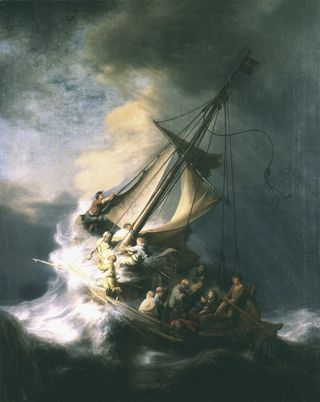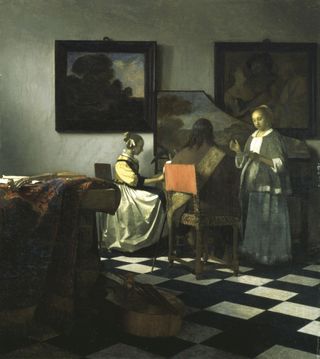Biggest Art Heist Ever: Will Released Tape Bring Paintings Back?

A 25-year-old security video is raising new questions in the mystery of who pulled off the biggest art heist in American history.
On Thursday (Aug. 6), the Federal Bureau of Investigation released a fuzzy clip of a hatchback pulling up to a side door at the Isabella Steward Gardner Museum in Boston. In the video, a man gets out of the car and is let in a museum side door by the security guard on duty, Richard Abath.
The sequence is intriguing because of what happened almost exactly 24 hours later: Abath again buzzed in people who shouldn't have been there, this time two men dressed as police officers. The fake officers bound Abath and another guard with duct tape and made off with 13 works of art, including three Rembrandts and a Vermeer. The lost works are valued at $500 million. [Lost Art: See Images of Gardner Heist Paintings]
"It was the single largest property crime in U.S. history," said Robert Wittman, a retired special agent who founded the FBI's national Art Crime Team in 2005. Wittman, author of "Priceless: How I Went Undercover to Rescue the World's Stolen Treasures" (Broadway Books, 2011), worked undercover on the Gardner case between 2006 and 2008.
Twisted mystery
The Gardner heist went off in the early morning hours of March 18, 1990. Since then, there have been tantalizing clues as to the art's whereabouts, including a ransom note sent to the museum in 1994, an alleged viewing of one of the stolen paintings by a Boston Herald reporter in 1997, and an offer made to an undercover Wittman to sell a Rembrandt and a Vermeer in 2006. Authorities investigating other art thefts blew Wittman's cover before he could secure the deal. [9 Famous Art Forgeries]

Abath has always denied any involvement in the art heist. The newly revealed video is a significant step in the investigation because it seems to contradict Abath's denials of wrongdoing, said Stephen Kurkjian, a Pulitzer-Prize winning journalist who was the principal reporter on the Gardner case for The Boston Globe.
Sign up for the Live Science daily newsletter now
Get the world’s most fascinating discoveries delivered straight to your inbox.
"The car that was used the night of the theft is described as a hatchback, and the car that pulls up as seen in the new video appears to be a hatchback," said Kurkjian, who recently released a book about the case, "Master Thieves: The Boston Gangsters Who Pulled Off the World's Greatest Art Heist" (PublicAffairs, 2015). "So that's very troubling that he would have allowed someone who was unapproved to be inside the museum during that night watch. That's a breach of protocol, so now we know he breached protocol twice, the night of the theft and the same time the previous night."
The new release also raises questions about whether the FBI had previously tracked down the lead presented in the tape, Kurkjian told Live Science.
Wittman speculated that the FBI might be releasing the tape in order to confirm information on the person's identity given by Abath. The tape is not new to the FBI, he said, but there have likely been around four generations of agents working on the case, and older investigations of the tape might not have been documented for the agents working the case now. Wittman was not aware of the tape when he was in the FBI, he told Live Science. As an undercover agent, he said, he was not looking at the case files or evidence.
Recovering the Gardner art
Although valued at $500 million, the stolen artwork is likely worth nothing to the thieves. Some of the paintings were cut from their wooden stretchers, an act that would severely damage, if not destroy them, Wittman said. And in any case, such famous works would incriminate anyone who bought them, making them worthless on the black market. [Image Gallery: How Technology Reveals Hidden Art Treasures]
"No one is going to pay a penny for any of these pieces," Kurkjian said.
So why steal them? Kurkjian suspects the original thieves (or their bosses) believed that the paintings would act as a sort of insurance policy: If the police caught them for their involvement in organized crime, they could wiggle out of jail time by promising to lead authorities to the stolen paintings.
"They call it a get-out-of-jail-free card," Kurkjian said. "That's what they believe, but it's a myth. I've never seen it put to the test."
For his part, Wittman blames simple incompetence. People who steal art typically aren't art thieves, he said. They're criminals who do everything from stealing cars to robbing banks. For art to have value, it has to have history and provenance, but art thieves don’t know that, he said. "They're not in the business."
Many of the FBI's early suspects in the case — most involved in organized crime in the Boston area — are now dead. Abath lives in Vermont and has written his own book about the crime. The Gardner museum has offered a $5 million reward to anyone who gives information leading to the safe return of the artwork (or a partial reward for the return of some of the pieces). Empty frames still hang on the walls in the galleries where the art used to be on display.
The FBI believes the original thieves to be dead, but their friends, family and associates may know where the art is now. Kurkjian believes it will take more than money to loosen lips.
"I would put out there people who may have credibility in the bad-guy world, and I don't mean criminals," Kurkjian said. Instead, he said, the plea should come from people who represent redemption to Boston's underbelly, such as Boston Cardinal Seán Patrick O'Malley or mayor Marty Walsh, who has spoken about his recovery from alcoholism.
"I would put them in front of the frames, and I would say this: These people, this artwork, was collected for one transcendent reason, and that was to inspire Bostonians specifically, but [also] the art world in general, to come up with an American tradition of art," Kurkjian said. Without the lost pieces, which include the only seascape Rembrandt ever painted, that inspiration is gone, he said.
"I would appeal to the bad guys in their realm to say, you know, we all have a chance of redemption, and our chance of redemption is our children and our grandchildren," Kurkjian said. "So get those paintings back on the wall so your grandchildren and mine can see these paintings back on their wall."
Editor's Note: This article was updated to correct the spelling of Wittman.
Follow Stephanie Pappas on Twitter and Google+. Follow us @livescience, Facebook & Google+. Original article on Live Science.

Stephanie Pappas is a contributing writer for Live Science, covering topics ranging from geoscience to archaeology to the human brain and behavior. She was previously a senior writer for Live Science but is now a freelancer based in Denver, Colorado, and regularly contributes to Scientific American and The Monitor, the monthly magazine of the American Psychological Association. Stephanie received a bachelor's degree in psychology from the University of South Carolina and a graduate certificate in science communication from the University of California, Santa Cruz.
Most Popular



